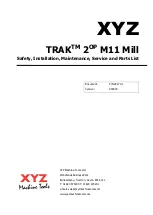
© Copyright 2013 TRENDnet. All Rights Reserved.
TRENDnet User’s Guide
TEW752DRU
51
Firewall Settings
Enable SPI: Tick the check box to enable the Stateful Packet Inspection (SPI)
feature. SPI, also known as dynamic packet filtering, helps to prevent cyber-
attacks. It validates that the traffic passing through the session conforms to the
protocol.
DMZ Host
Enable DMZ: Tick the check box to enable the Demilitarized Zone (DMZ) feature.
DMZ IP Address: Enter or select the local DMZ IP address.
Application Level Gateway (ALG) Configuration
PPTP: Tick the check box to allow PPTP traffic. This feature allows multiple
machines on the LAN to connect to their corporate network using the PPTP
protocol.
IPSec (VPN): Tick the check box to allow IPSec (VPN) traffic. This feature allows
multiple VPN clients to connect to their corporate network using IPSec. Some
VPN clients support traversal of IPSec through NAT. This ALG may interfere with
the operation of such VPN clients. If you are having trouble connecting with your
corporate network, try turning this ALG off. Please check with the system
administrator of your corporate network whether your VPN client supports NAT
traversal.
RTSP: Tick the check box to allow RSTP traffic. This feature allows an
application that uses Real Time Streaming Protocol to receive streaming media
from the Internet. QuickTime and Real Player are some of the common
applications using this protocol.
SIP: Tick the check box to allow SIP traffic. This feature allows devices and
applications using VoIP (Voice over IP) to communicate across NAT. Some VoIP
applications and devices have the ability to discover NAT devices and work
around them. This ALG may interfere with the operation of such devices. If you
are having trouble making VoIP calls, try turning this ALG off.
Firewall Rules
Checkbox: Tick the check box of each entry to enable the selected rule.
Name: Enter the name of the firewall rule.
Action: Select to Allow or Deny this rule.
Interface: Select the Source and Destination interface.
IP Address: Enter the source and destination IP address ranges that will be
used in this rule.
Protocol: Select the protocol type. Options to choose from are TCP, UDP, and
ICMP.
Port Range: Enter a range of ports that will be used in this rule.
Schedule: Select the time schedule for the rule. Click the New Schedule button
to create time schedules.
















































